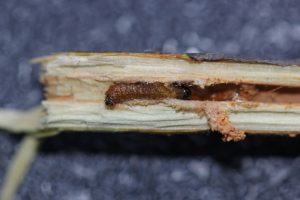Linda rubescens
Crop: Apple
Why is it a problem?
Larvae bore into stems, causing twig dieback. This is most damaging in seedlings, where the main leading shoot can be destroyed.
Where and when is it a problem?
Outbreaks are quite localized and rare. They have been reported in apple orchards in the Paro and Thimphu valleys.
IDENTIFICATION

Adult beetles are about 2 cm long and are easily recognized. They are reddish-orange with long (13–15 mm), black antennae, and two black spots on the prothorax (the segment between the head and main body). Larvae are orange with a dark head and reach 25 mm when fully grown.
SYMPTOMS
When females are laying the egg, they ring-bark the stem, causing the terminal end to die. The dead or dying leaves on the infested twigs make them very easy to spot. Larvae then enter the shoot before making a narrow tunnel downward through the center, causing a die-back of the shoot above the damaged portion. Frass (remains of feeding) is pushed out through holes on the outside on occasion. Damage is more serious in seedling trees, where the main leading shoot can be destroyed. Damage due to the twig borer can be confirmed by cutting open the twig where the larva can be easily observed.
Confusion with other pests: Make sure that stem dieback is the result of a twig borer and not something else, such as boron deficiency. Damage cannot be confused with other types of twig dieback, but in case of doubt, the feeding tunnel in the twig can confirm identification. Usually, the larva can also be found by cutting the twig open lengthwise.
BIOLOGY
Lifecycle: In April/May, the female bites a small part of the bark of the twigs of grown-up trees or the main stem of seedlings and lays eggs in the cuts. The bark of the selected twig is further fed upon until it is ring-barked, causing the terminal section of the twig to die. Pupation occurs within the tunnel, and adults emerge from the twigs in April/May. The full life cycle probably takes two years.
Dispersal: Adults can fly.
When can damage be expected? This species has a long lifecycle (2 years), so populations are likely to take a long time to build up.
Hosts: It has only been reported from apple trees.
MANAGEMENT PRACTICES
This pest is easily found and managed without the use of chemicals.
Monitoring
Inspect shoots and twigs bearing dead leaves that indicate that the shoot is being tunneled
Effect of variety
Not known.
Non-chemical management
- The presence of shoots bearing dead leaves gives a clear warning that the shoot is being tunneled. Infested shoots should be cut off, collected, and then burned as soon as possible.
- During winter pruning, make sure beetle-damaged stems are cut off and burned.
Chemical management
Chemical spray is not effective as the larvae are well protected inside the woody shoots.
Version: NPPC 2022. Apple twig borer V1.0. Bhutan Pest Factsheet. www.PestsofBhutan.nppc.gov.bt. Date produced: 9 December, 2022. Last date modified: March 1, 2024. Contact: NPPC
Image acknowledgements: NPPC.



